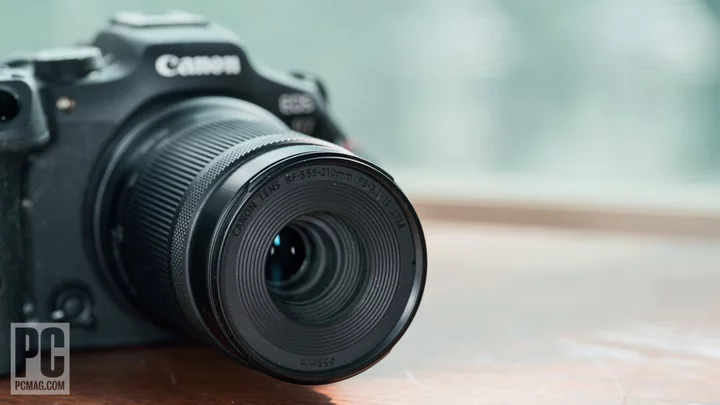The Canon RF-S 55-210mm F5-7.1 IS STM ($349.99) puts telephoto optics in a stunningly slim and light package, making it an ideal match for Canon's smallest mirrorless cameras. The lens delivers sharp pictures and locks in focus accurately, but it won't add much extra zoom capability to your kit if you already have the RF-S 18-150mm ($499.99). As such, we recommend budgeting more for the RF 100-400mm F5.6-8 IS USM ($649.99) if you're interested in team sports and wildlife; it's a better investment thanks to its longer range and full-frame coverage.
A Truly Small Telezoom
When it comes to telephoto lenses, the words small and light are often relative because big zooms for full-frame cameras regularly approach 5 pounds. The RF-S 55-210mm meanwhile weighs a mere 9.5 ounces and measures just 3.7 by 2.7 inches (HD). Canon did have to make some compromises along the way though: The lens covers only APS-C image sensors and uses a relatively dim F5-7.1 variable aperture. A bright prime lens, like the RF 50mm F1.8 STM ($199.99), is a better addition to your kit if you want to snap photos in low light.
(Credit: Jim Fisher)Of course, a 50mm prime won't get you as close to distant subjects. The 55-210mm zooms in tight enough to catch critters visiting your backyard, has the reach to get sports snaps from the stands, and is appropriate for sessions at the zoo. It's a little short for birds and wildlife, so consider spending more on the RF 100-400mm if you are putting together a kit for a trip to a national park. That said, it worked just fine to grab some images of a neighborhood hawk.
EOS R7, 210mm, f/8, 1/500-second, ISO 400 (Credit: Jim Fisher)The RF-S 55-210mm makes the most sense with Canon's smallest cameras: the EOS R100 (which I used for field testing) and the R50. At press time, it adds $230 to either camera bundle versus buying them with just the RF-S 18-45mm, a decent savings compared with retail. If you aren't sold on those bodies though, it's also a good match with the EOS R10.
Construction quality is right in line with the other RF-S kit lenses. Like the 18-45mm, the 55-210mm has an all-plastic barrel and lens mount. It feels sturdy enough and I'm not worried about gravity putting too much stress on the bayonet given the featherweight design.
(Credit: Jim Fisher)The lens doesn't offer any weather sealing, so I don't recommend using it in the rain. Canon includes front and rear caps, but not a lens hood in the box. The front element is fairly small, plus uses an anti-reflective Super Spectra Coating, so flare shouldn't be too much of a problem without a hood, but if you still want one for additional protection, the compatible ET-60B costs $30.
RF-S 55-210mm F5-7.1 IS STM Handling and Controls
Most small lenses extend to zoom and the RF-S 55-210mm follows suit. It's a couple of inches longer at 210mm than at 55mm. The zoom control ring occupies most of the barrel and feels fine to operate. It simultaneously offers enough resistance to hold its focal length and doesn't require a lot of torque to turn. It doesn't lock at its minimum focal length, which makes for quicker operations. Canon opts for a ridged plastic texture here, which is not quite as comfy to use as the rubberized control rings on upmarket alternatives, but that's a reasonable compromise for the price.
(Credit: Jim Fisher)The manual focus ring uses a diamond pattern rather than ridges. The ring is rather narrow but is easy enough to find by touch at its forward position on the barrel. It turns a little too easily to make precise adjustments but I expect most photogs who pick this lens will rely on autofocus.
Speaking of, the autofocus performance is fairly snappy. The internal stepping motor (STM) is more than capable enough to drive the lightweight optical elements. Focus shifts between different subjects without any troublesome lag, even when I tested it with the entry-level R100 camera. Focus breathing, or the change in angle of view that comes from a shift in focus, is completely absent—a benefit for video creators.
EOS R100, 155mm, f/7.1, 1/800-second, ISO 100 (Credit: Jim Fisher)The lens offers decent macro capabilities, too. It gets 1:3.5 life-size magnification at its nearest focus distance, about 2.3 feet from the sensor. Both the RF-S 18-150mm (1:2.3) and RF 100-400mm (1:2.4) are a bit more versatile for macro work, however.
Canon includes optical stabilization here, a real benefit since most of its crop-sensor cameras omit sensor-based stabilization. It says the 55-210mm's stabilization system should be good for about 4.5 stops of compensation, which is right in line with my testing. I consistently got results free of shake-induced blur at 1/8-second and 210mm, though 1/4-second exposures were a bit too much to manage.
EOS R7, 210mm, f/7.1, 1/640-second, ISO 100 (Credit: Jim Fisher)EOS R7 owners get up to 7 stops of compensation thanks to that camera's in-body stabilization, but I don't expect many people with Canon's pro-minded APS-C body to consider an entry-level lens. Don't get me wrong, that camera and this lens pair well in tests, but enthusiasts and pros are more likely to shop for L series lenses.
RF-S 55-210mm: In the Lab
I attached the RF-S 55-210mm to the R7 for lab tests because our standard practice is to use the highest-pixel-count body available whenever possible. Imatest shows excellent results throughout the entire range, around 3,500 lines at maximum aperture. You can stop down a little bit to get more depth of field, but be aware that picture quality drops off starting at f/16 due to diffraction.
EOS R7, 70mm, f/7.1, 1/320-second, ISO 100 (Credit: Jim Fisher)Sunstars look poor at these higher apertures. The lens is also prone to show ghosts if the sun is in the frame at these settings, versus a more pleasing soft flare wide-open. There's a slight drop in contrast if you point the lens at a bright light source, too.
The optics show some pincushion distortion, but you won't notice that if you use your camera in JPG mode—in-camera corrections straighten inwardly curved lines. The lens also casts a vignette at maximum aperture, but your camera's JPG engine takes care of that as well by brightening the corners.
If you opt for the Raw format, use an image processor that supports profile corrections—Adobe Lightroom Classic has one that takes care of the distortion and vignette upon import.
EOS R7, 210mm, f/7.1, 1/500-second, ISO 5000 (Credit: Jim Fisher)I couldn't spot any evidence of chromatic aberrations in photos, and this lack of false color makes defocused backgrounds look clean. The narrow aperture limits how much bokeh you get, of course, but I didn't see any ugly artifacts in images with a noticeably shallow depth of field.
(Credit: Jim Fisher)A Good Value in the Right Kit
Whether the RF-S 55-210mm F5-7.1 IS STM makes sense for you depends on what standard zoom you pick for your Canon RF camera. If you start with the RF-S 18-150mm, I don't see much point in adding a 55-210mm, as the extra bit of reach is negligible. On the other hand, it's a sensible complement to the RF-S 18-45mm, especially in a kit with an EOS R100 or R50. If you want to take better wildlife and sports photos, however, you should step up to the RF 100-400mm for its extra zoom power and faster focus motor.









